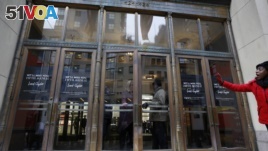09 August, 2019
The idea of a flagship store is more than one hundred years old.
In the past, it was often a company's biggest store — one in their first or most famous location. For example, Macy's and Tiffany's have flagship stores in New York City.

A woman waves from the sidewalk as another locks the front door at Lord & Taylor's Fifth Avenue flagship store which closed for good mid-afternoon, Jan. 2, 2019, in New York.
But Americans' shopping customs are changing. As a result, companies are closing more flagship stores in well-known shopping areas in the United States.
For example, Gap, Tommy Hilfiger, Lord & Taylor and Polo Ralph Lauren have recently closed their flagship stores on Manhattan's Fifth Avenue.
The store closures are a result of increasing rent prices and increasing levels of online shopping, experts say.
The latest victim to the changes could be Barneys New York. It opened its 10-story Madison Avenue store in 1993. Barneys became a cultural icon in luxury shopping but now risks closure.
Joseph Aquino runs a real estate services firm. "We are in the phase where a lot of younger shoppers don't want to go to the high street. They sit around and buy online and that's what we are fighting against," he said.
Still, flagship stores are not completely dead. Many companies like Nike and Levi are creating new kinds of stores with fewer items to sell but more high-technology experiences.
For example, Nike opened a store on Fifth Avenue late last year that does not have any cash registers. Instead, shoppers use their cell phones to see details about the items in the store. Shoppers can then have those items delivered to a place where they can try them on or pick them up.
Another example is Levi Strauss & Co.‘s new flagship in Manhattan's Times Square. It has large dressing rooms where shoppers can call workers to fix their jeans so they fit perfectly.
However, in place of large flagship stores, a growing number of retailers are thinking smaller. Hollister, for instance, is developing smaller stores that offer online services and serve both local and tourist customers.
Tommy Hilfiger will also be testing smaller shops with online interaction.
Stacey Widlitz gives companies advice about the shopping business. She says they do not need huge stores anymore. She says, "Shoppers are shopping completely differently." Widlitz adds shoppers do not need to see everything a company is selling. Instead, shoppers need only to get to know the company.
Caroline Nash of Washington, D.C. is 18 years old. She says she finds huge stores overwhelming, especially when she can get the same items online.
She says she links flagship stores to long lines and big crowds. Nash adds: "Unless it is something that offers a different experience, I'm not interested."
I'm John Russell.
Anne D'Innocenzio reported on this story for the Associated Press. John Russell adapted it for Learning English. Kelly Jean Kelly was the editor.
_____________________________________________________________
Words in This Story
icon – n. a widely known symbol
phase -- n. a short period of time during which a person behaves in a particular way or likes a particular thing
overwhelming -- adj. used to describe something that is so confusing, difficult, etc., that you feel unable to do it
We want to hear from you. Write to us in the Comments Section